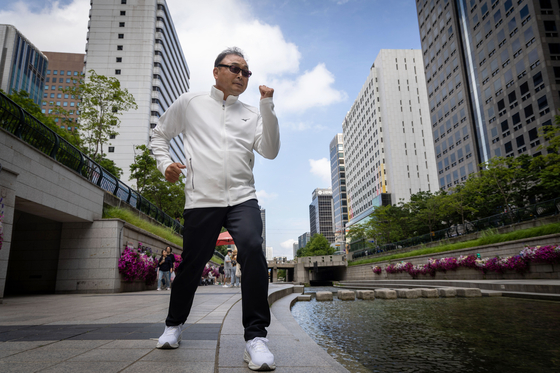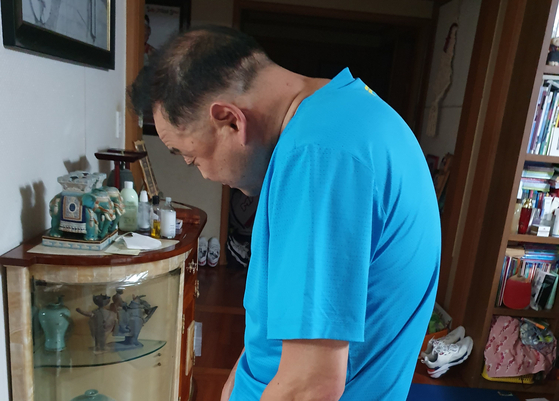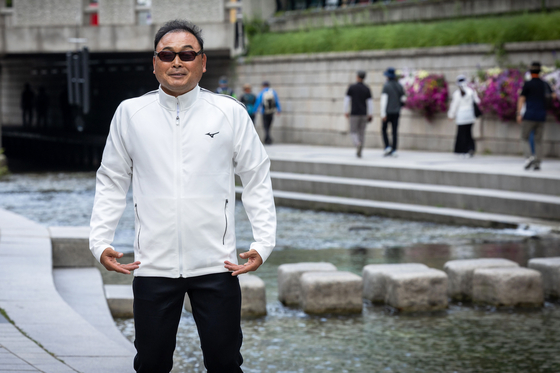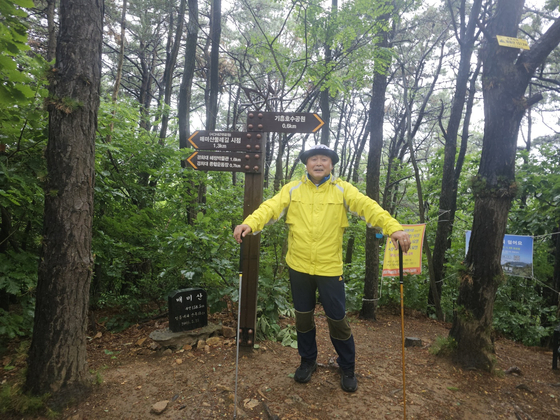Return of the Resilient Runner: Lee Bong-ju Set to Make a Remarkable Comeback After Battling Rare Disorder

Lee Bong-ju poses during an interview with the JoongAng Ilbo at the Cheonggye stream in central Seoul on June 10. [JOONGANG ILBO]
Not long ago, Korea's most celebrated marathon runner, Lee Bong-ju, couldn’t stand without a cane. This fall, he’ll run a 10-K in Vietnam.
Lee — the silver medalist at the 1996 Atlanta Olympics and national record-holder — is staging an improbable comeback after spending years suffering from dystonia, a rare neuromuscular disorder.
Now 54, Lee has clawed his way back to health. In November, he’ll toe the starting line at the Ha Long Bay International Marathon, marking his first race since being sidelined by a condition that left him barely able to walk.
“I’m not marathon-ready,” Lee said, laughing during an interview with the JoongAng Ilbo in central Seoul. “But I can run 10 kilometers [6.2 miles]. That’s enough to feel alive.”
His walk through the Cheonggye stream area turned heads. Some pedestrians paused, whispering in recognition. Others greeted him warmly, asking for autographs. A few were stunned.
“You look completely better now,” one said.
For years, that seemed unlikely.
Known affectionately as "Bongdari" during his athletic career, Lee has made a visible recovery.
He had spent the past four years battling dystonia, which causes involuntary muscle contractions. It struck Lee’s abdominal muscles first. Over time, his spine contorted. His neck bent downward until he couldn’t face the sky. Treatments failed. Botox, nerve blocks — nothing helped. A 2022 surgery to remove a spinal cyst only made things worse.

Lee Bong-ju during the period when he was suffering from dystonia [JOONGANG ILBO]
He could only walk with a cane when the symptoms peaked two years ago.
“I had surgery to remove a spinal cyst after a doctor suggested it might help two years ago. But after that, my neck bent even more. My wife told me not to go through with it, and she was right — I got an earful afterward.”

Lee Bong-ju poses during an interview with the JoongAng Ilbo at the Cheonggye stream in central Seoul on June 10. [JOONGANG ILBO]
Lee dedicated himself to rehabilitation at his home in Suwon, Gyeonggi, after the surgery.
He said the pain was manageable. With help from his wife, who gave him regular massages, and equipment like an automated acupressure bed, he combined at-home care with physical therapy at a rehab clinic.
He used a gym ball and other tools to relax his back and shoulder muscles.
But he said what helped most was walking up Mount Maemi, a 158-meter (518-foot) hill near his home.
“I didn’t stay in bed. I kept moving,” he said. “At first, I used a cane, then I switched to a walking stick I made from a golf club shaft. It’s lighter than a trekking pole.”
Lee now hikes daily at 5 a.m., or 6 a.m. in the winter.
His 8-kilometer route begins at Nongseo Neighborhood Park in Seocheon-dong, Yongin, and takes him over Mount Maemi and Mount Aram before descending to Kyung Hee University’s international campus.

Lee Bong-ju poses at Mount Maemi in Suwon, Gyeonggi, on June 21. [JOONGANG ILBO]
Most of the trail is unpaved and popular with barefoot hikers. After the two-hour walk on an empty stomach, he returns home for a vegetable-based meal prepared by his wife.
Mount Maemi has long been a part of Lee’s life. He moved to the area 25 years ago during his time with Samsung Electronics’ athletics team because the mountain was home to a training facility.
Cross-country workouts on Mount Maemi helped him build the strength to set a still-unbroken national record of 2:07:20 at the 2000 Tokyo International Marathon.
He became the third Korean to win the Boston Marathon in 2001, finishing in 2:09:43, following Seo Yun-bok in 1947 and Ham Kee-yong in 1950.
Having regained his health, Lee said he wants to spend the rest of his life running with others who love the sport.
Even before his illness, he had participated in charity runs for spinal patients and shared his training know-how with younger athletes.
“I feel like I’ve come back from the brink,” he said. “Now I want to be an ambassador for running.”
His return coincides with a nationwide running boom.
From full and half marathons to 5- and 10-kilometer fun runs, races are attracting participants of all ages. Trail running, which takes place on unpaved mountain paths, is also growing rapidly.
Lee plans to mark his return with a race at the Ha Long Bay International Marathon in Vietnam in November, where he will run either 5 or 10 kilometers.
Lotte Tour is offering a three-night, five-day “Ha Long Bay Marathon with Lee Bong-ju” package, and a motivational talk by Lee called “Running for Life.”
“We expect more than 1,000 Koreans to join the trip,” a Lotte Tour representative said.
Translated from the JoongAng Ilbo using generative AI and edited by Korea JoongAng Daily staff.
BY KIM YOUNG-JU [paik.jihwan@joongang.co.kr]
Post a Comment for "Return of the Resilient Runner: Lee Bong-ju Set to Make a Remarkable Comeback After Battling Rare Disorder"
Post a Comment